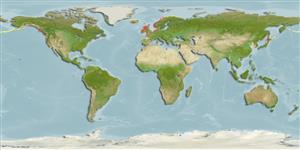Tubulanus polymorphus (Renier, 1804)
Orange ribbon worm| Native range | All suitable habitat | Point map | Year 2050 |

|
| This map was computer-generated and has not yet been reviewed. |
| Tubulanus polymorphus AquaMaps Data sources: GBIF OBIS |
Google image |
No photo available for this species.
Classification / Names Common names | Synonyms | CoL | ITIS | WoRMS
Palaeonemertea | Tubulaniformes | Tubulanidae
Environment: milieu / climate zone / depth range / distribution range Ecology
Benthic; brackish; depth range 0 - 45 m (Ref. 124752). Temperate; 63°N - 30°N, 180°W - 37°E
Distribution Countries | FAO areas | Ecosystems | Occurrences | Introductions
Northeast Atlantic, Arctic Sea, the Mediterranean and Northern Pacific.
Length at first maturity / Size / Weight / Age
Maturity: Lm ? range ? - ? cm Max length : 300 cm TL male/unsexed; (Ref. 930)
Life cycle and mating behavior Maturity | Reproduction | Spawning | Eggs | Fecundity | Larvae
Main reference
References | Coordinator | Collaborators
Blake, J.A. 1993 6. Phylum Nemertea. p. 95-132. In Blake, J.A. and A. Lissner (eds.) Taxonomic Atlas of the Benthic Fauna of the Santa Maria Basin and Western Santa Barbara Channel. Vol. 1. Introduction, benthic ecology, oceanography, Platyhelminthes, and Nemertea. (Ref. 966)
IUCN Red List Status
(Ref. 130435: Version 2025-1)
CITES status (Ref. 108899)
CMS (Ref. 116361)
Threat to humans
Human uses
| FishSource |
Tools
More information
Diet composition
Food consumption
Predators
Max. ages / sizes
Length-weight rel.
Length-length rel.
Length-frequencies
Mass conversion
Abundance
Internet sources
BHL | BOLD Systems | CISTI | DiscoverLife | FAO(Publication : search) | Fishipedia | GenBank (genome, nucleotide) | GloBI | Gomexsi | Google Books | Google Scholar | Google | PubMed | Tree of Life | Wikipedia (Go, Search) | Zoological Record


